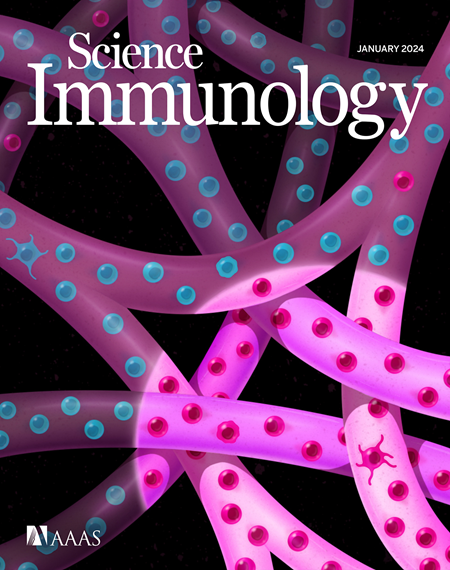Palmitoylation of TIM-3 promotes immune exhaustion and restrains antitumor immunity
IF 17.6
1区 医学
Q1 IMMUNOLOGY
引用次数: 0
Abstract
T cell immunoglobulin and mucin domain–containing protein 3 (TIM-3) is an immune checkpoint that has critical roles in immune exhaustion. However, little is known about the mechanisms that regulate TIM-3 surface expression and turnover. Here, we report that human TIM-3 is palmitoylated by the palmitoyltransferase DHHC9 at residue cysteine 296 (Cys296). Palmitoylation stabilized TIM-3 by preventing binding to E3 ubiquitin ligase HRD1, thereby suppressing its polyubiquitination and degradation. DHHC9 knockdown attenuated chimeric antigen receptor T (CAR-T) cell exhaustion, and a peptidic inhibitor of TIM-3 palmitoylation accelerated TIM-3 degradation and enhanced antitumor immunity mediated by CAR-T cells and natural killer (NK) cells. In hepatocellular carcinoma, DHHC9 expression correlated with TIM-3 expression in CD8+ T cells and NK cells, and high DHHC9 expression was associated with shorter survival in patients with high TIM-3. These findings demonstrate that palmitoylation of TIM-3 catalyzed by DHHC9 promotes its stability, resulting in immune exhaustion and impaired antitumor immunity.

TIM-3 的棕榈酰化促进免疫衰竭并抑制抗肿瘤免疫力
T 细胞免疫球蛋白和含粘蛋白结构域的蛋白 3(TIM-3)是一种免疫检查点,在免疫衰竭中起着至关重要的作用。然而,人们对调控 TIM-3 表面表达和周转的机制知之甚少。在这里,我们报告了人类 TIM-3 被棕榈酰基转移酶 DHHC9 在半胱氨酸残基 296(Cys 296)处棕榈酰化。棕榈酰化可阻止 TIM-3 与 E3 泛素连接酶 HRD1 结合,从而抑制其多泛素化和降解,从而使 TIM-3 稳定。DHHC9敲除可减轻嵌合抗原受体T(CAR-T)细胞的衰竭,TIM-3棕榈酰化的多肽抑制剂可加速TIM-3降解,增强CAR-T细胞和自然杀伤(NK)细胞介导的抗肿瘤免疫。在肝细胞癌中,DHHC9的表达与CD8 + T细胞和NK细胞中TIM-3的表达相关,DHHC9的高表达与高TIM-3患者的生存期缩短有关。这些研究结果表明,DHHC9催化的TIM-3棕榈酰化促进了TIM-3的稳定性,导致免疫耗竭和抗肿瘤免疫受损。
本文章由计算机程序翻译,如有差异,请以英文原文为准。
求助全文
约1分钟内获得全文
求助全文
来源期刊

Science Immunology
Immunology and Microbiology-Immunology
CiteScore
32.90
自引率
2.00%
发文量
183
期刊介绍:
Science Immunology is a peer-reviewed journal that publishes original research articles in the field of immunology. The journal encourages the submission of research findings from all areas of immunology, including studies on innate and adaptive immunity, immune cell development and differentiation, immunogenomics, systems immunology, structural immunology, antigen presentation, immunometabolism, and mucosal immunology. Additionally, the journal covers research on immune contributions to health and disease, such as host defense, inflammation, cancer immunology, autoimmunity, allergy, transplantation, and immunodeficiency. Science Immunology maintains the same high-quality standard as other journals in the Science family and aims to facilitate understanding of the immune system by showcasing innovative advances in immunology research from all organisms and model systems, including humans.
 求助内容:
求助内容: 应助结果提醒方式:
应助结果提醒方式:


